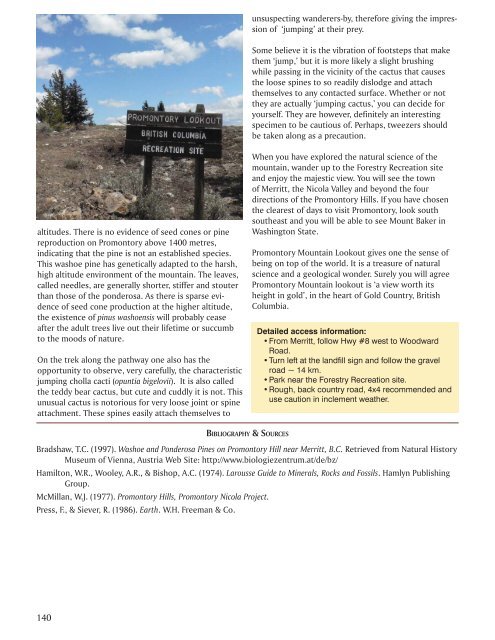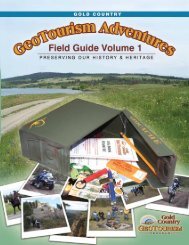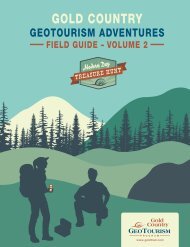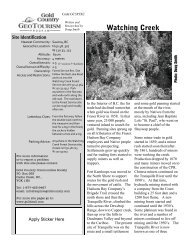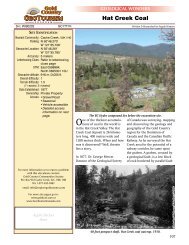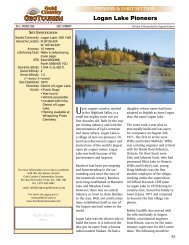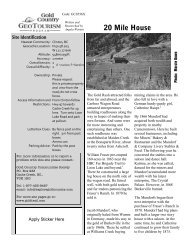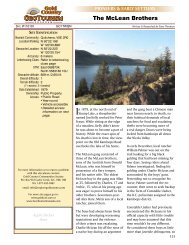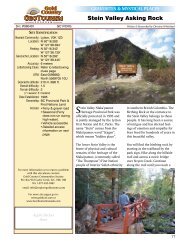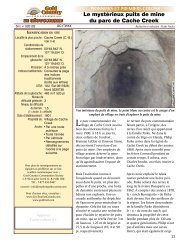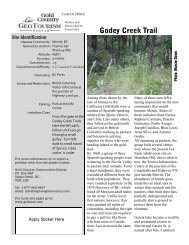E book Field Guide.indd - Gold Country
E book Field Guide.indd - Gold Country
E book Field Guide.indd - Gold Country
You also want an ePaper? Increase the reach of your titles
YUMPU automatically turns print PDFs into web optimized ePapers that Google loves.
unsuspecting wanderers-by, therefore giving the impression<br />
of ‘jumping’ at their prey.<br />
Some believe it is the vibration of footsteps that make<br />
them ‘jump,’ but it is more likely a slight brushing<br />
while passing in the vicinity of the cactus that causes<br />
the loose spines to so readily dislodge and attach<br />
themselves to any contacted surface. Whether or not<br />
they are actually ‘jumping cactus,’ you can decide for<br />
yourself. They are however, definitely an interesting<br />
specimen to be cautious of. Perhaps, tweezers should<br />
be taken along as a precaution.<br />
altitudes. There is no evidence of seed cones or pine<br />
reproduction on Promontory above 1400 metres,<br />
indicating that the pine is not an established species.<br />
This washoe pine has genetically adapted to the harsh,<br />
high altitude environment of the mountain. The leaves,<br />
called needles, are generally shorter, stiffer and stouter<br />
than those of the ponderosa. As there is sparse evidence<br />
of seed cone production at the higher altitude,<br />
the existence of pinus washoensis will probably cease<br />
after the adult trees live out their lifetime or succumb<br />
to the moods of nature.<br />
On the trek along the pathway one also has the<br />
opportunity to observe, very carefully, the characteristic<br />
jumping cholla cacti (opuntia bigelovii). It is also called<br />
the teddy bear cactus, but cute and cuddly it is not. This<br />
unusual cactus is notorious for very loose joint or spine<br />
attachment. These spines easily attach themselves to<br />
When you have explored the natural science of the<br />
mountain, wander up to the Forestry Recreation site<br />
and enjoy the majestic view. You will see the town<br />
of Merritt, the Nicola Valley and beyond the four<br />
directions of the Promontory Hills. If you have chosen<br />
the clearest of days to visit Promontory, look south<br />
southeast and you will be able to see Mount Baker in<br />
Washington State.<br />
Promontory Mountain Lookout gives one the sense of<br />
being on top of the world. It is a treasure of natural<br />
science and a geological wonder. Surely you will agree<br />
Promontory Mountain lookout is ‘a view worth its<br />
height in gold’, in the heart of <strong>Gold</strong> <strong>Country</strong>, British<br />
Columbia.<br />
Detailed access information:<br />
• From Merritt, follow Hwy #8 west to Woodward<br />
Road.<br />
• Turn left at the landfill sign and follow the gravel<br />
road ~ 14 km.<br />
• Park near the Forestry Recreation site.<br />
• Rough, back country road, 4x4 recommended and<br />
use caution in inclement weather.<br />
BIBLIOGRAPHY & SOURCES<br />
Bradshaw, T.C. (1997). Washoe and Ponderosa Pines on Promontory Hill near Merritt, B.C. Retrieved from Natural History<br />
Museum of Vienna, Austria Web Site: http://www.biologiezentrum.at/de/bz/<br />
Hamilton, W.R., Wooley, A.R., & Bishop, A.C. (1974). Larousse <strong>Guide</strong> to Minerals, Rocks and Fossils. Hamlyn Publishing<br />
Group.<br />
McMillan, W.J. (1977). Promontory Hills, Promontory Nicola Project.<br />
Press, F., & Siever, R. (1986). Earth. W.H. Freeman & Co.<br />
140


